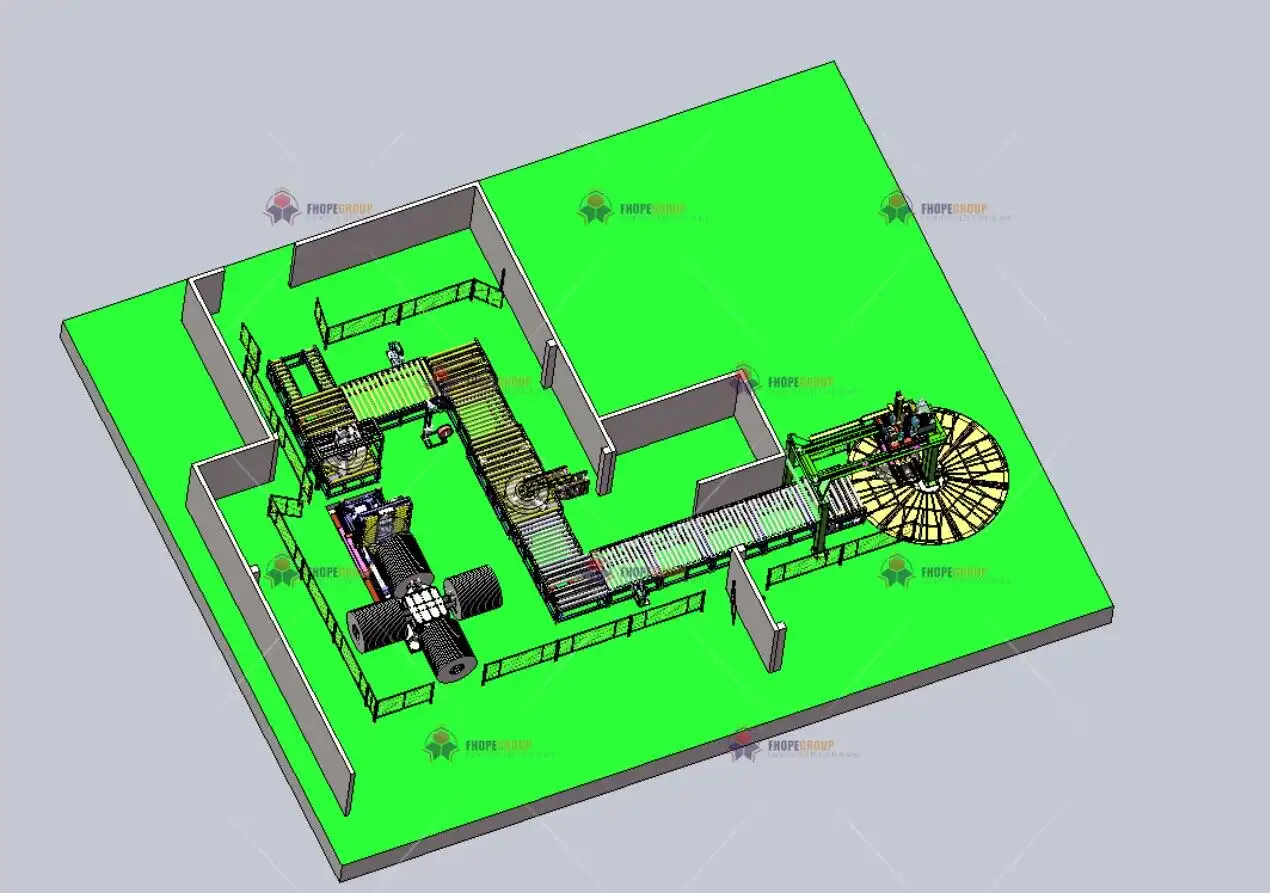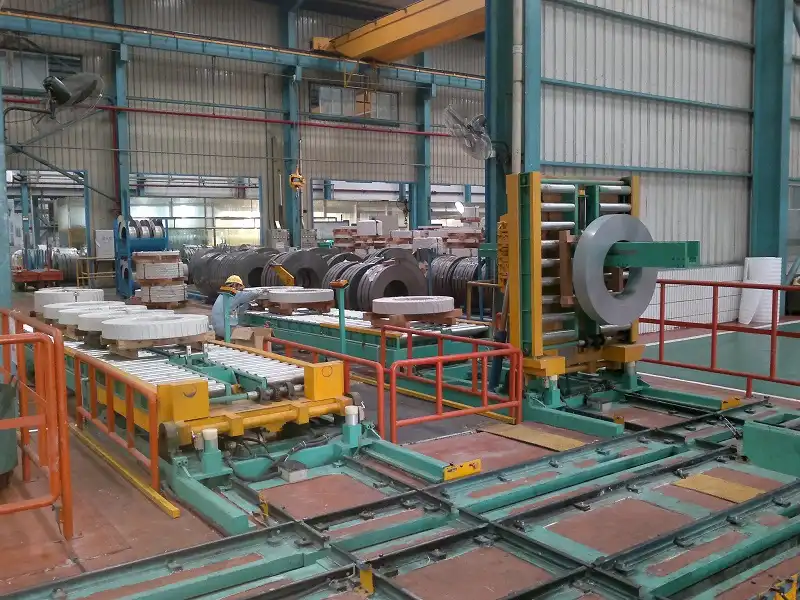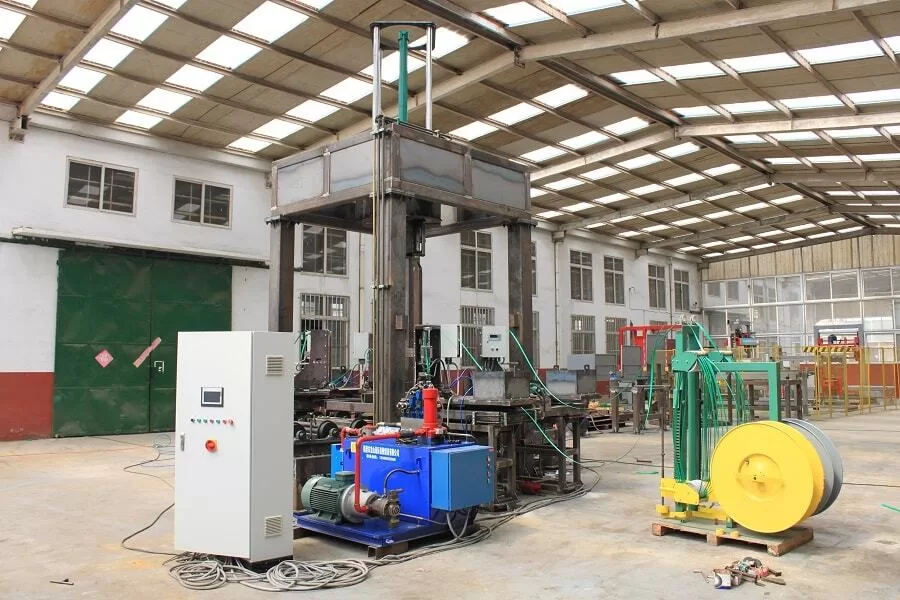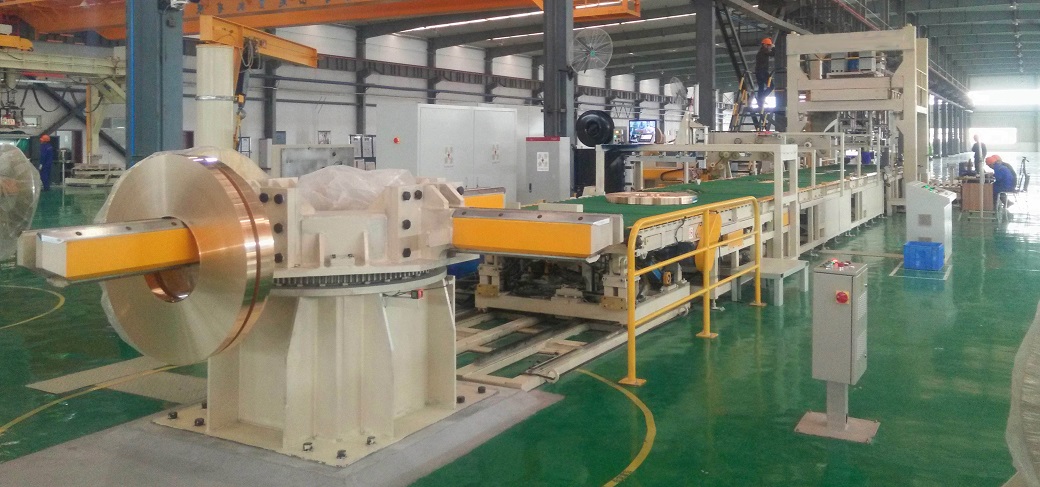Are you running a steel or aluminum slitting facility in Europe? You probably feel the constant pressure. You need to increase throughput, cut costs, and satisfy demanding customers. But your packing line often feels like a black box. You see coils go in and packed pallets come out, but you lack the real-time data to truly optimize the process. This lack of visibility can lead to hidden bottlenecks, unexpected downtime, and wasted materials. Every manual entry is a potential error, and every minute the line is idle, you're losing money. Meanwhile, your competitors are getting smarter, using data to pull ahead. As an engineer who has built a packing machine factory from the ground up, I’ve seen this struggle many times. The solution isn't just a faster machine; it's a smarter system. By integrating your slit coil packing line with your MES (Manufacturing Execution System) and ERP (Enterprise Resource Planning) software, you can transform your operations from reactive to data-driven, giving you the control you need to thrive in the competitive European market.
Integrating a slit coil packing line with MES/ERP systems in Europe creates smarter operations by connecting your physical machinery directly to your central business management software. This critical link provides a constant stream of real-time data on production rates, material consumption, and equipment health. It allows for automated order tracking from the front office to the factory floor, leading to major improvements in efficiency. Most importantly, it empowers you to make data-driven decisions that meet Europe's high standards for productivity, quality, and regulatory compliance.

This all sounds great, but what does it actually look like on your factory floor? How do you turn this concept into a practical reality that boosts your bottom line? It’s not just about buying new software. It’s about creating a seamless flow of information that empowers every person in your organization, from the operator to the CEO. Over the years, I've dedicated myself to not just building machines, but building total solutions. I want to share some of my direct experiences to help you understand how this integration works and the tangible benefits it can bring to your European operations. Let’s break it down.
How does MES/ERP integration transform a traditional slit coil packing line?
Does your packing line feel disconnected from the rest of your plant? Maybe operators are still working from printed-out order sheets, and your production planners only find out about a problem hours after it happens. This information gap is a huge source of inefficiency. A last-minute rush order comes in, and it creates chaos on the floor because there's no easy way to adjust the production queue. A machine stops, and the maintenance team is slow to respond because the alert was just a flashing light on the line, not a notification on their device. You're constantly fighting fires instead of preventing them. This is where integration creates a profound shift. By linking your packing line to the MES/ERP, you build a digital bridge that connects your business strategy directly to the machinery executing it. It’s about achieving a state of operational harmony.
MES/ERP integration transforms a traditional slit coil packing line by automating the exchange of information between your shop floor and your core business systems. This replaces manual data entry and guesswork with precise, real-time monitoring. The system can dynamically schedule packing jobs based on ERP priorities, send predictive maintenance alerts before a breakdown occurs, and automatically log quality control data for every single coil. This automation dramatically boosts productivity, reduces the chance of human error, and gives you a clear, accurate picture of your operations at all times.

From Isolated Island to Integrated Hub
In a traditional setup, the packing line is often an "island." Information arrives on paper and leaves on a pallet. The integration of MES/ERP completely changes this dynamic. The packing line becomes a fully integrated hub in your production ecosystem. When a sales manager enters an order into the ERP, the system can automatically generate a work order for the packing line. This order isn't just a piece of paper; it's a digital package of data sent directly to the machine's Human-Machine Interface (HMI). The operator sees the exact coil specifications, required packaging materials, and labeling instructions on their screen. There's no room for misinterpretation. I remember a client in the Netherlands whose biggest complaint was shipping errors due to operators grabbing the wrong paperwork. After integration, that problem vanished overnight.
A Single Source of Truth for Everyone
One of the most powerful outcomes of integration is creating a "single source of truth." Before, you might have different data in different places. The production report says one thing, the inventory log says another, and the operator's notes say something else entirely. This leads to confusion and arguments. With an integrated system, everyone works from the same real-time data. The plant manager, the maintenance chief, and the CEO can all look at the same dashboard and see the same KPIs. This transparency fosters accountability and collaborative problem-solving.
The Before and After of Integration
Let's look at the practical changes in a more structured way. The transformation touches every part of the packing process.
| Feature | Before Integration (Traditional) | After Integration (Smart) |
|---|---|---|
| Order Handling | Manual paperwork, verbal instructions | Digital work orders sent directly from ERP to HMI |
| Production Tracking | End-of-shift manual data entry | Real-time dashboards showing OEE, throughput, KPIs |
| Quality Control | Visual inspection, separate paper logs | Automated checks, data logged instantly to MES |
| Maintenance | Reactive; fix it when it breaks | Predictive; sensor data triggers maintenance alerts |
| Inventory | Manual counts, periodic estimates | Real-time tracking of film, strap, and label usage |
| Traceability | Difficult, requires searching paper records | Complete coil genealogy at the click of a button |
This shift moves your team from spending their time recording data to analyzing it. Instead of asking, "What happened yesterday?" you can start asking, "How can we make tomorrow better?" That is the true power of this transformation.
What are the key data points MES/ERP systems track in a European packing line?
You've decided to collect data, but now you face a new problem: what data is actually important? It's easy to get lost in a sea of numbers. Collecting too much information without a clear purpose leads to "analysis paralysis," where you're so overwhelmed that you do nothing. Tracking the wrong metrics can be even worse. You might push your team to increase the number of coils packed per hour, only to find that quality has suffered and re-wraps have skyrocketed. For a business leader focused on ROI, this is a nightmare. Your expensive new data system must deliver tangible results. The secret is to focus on a handful of Key Performance Indicators (KPIs) that are directly tied to the performance and profitability of a European slit coil packing line. From my experience helping clients set up these systems, there are a few data points that always deliver the most value.
In a European slit coil packing line, MES/ERP systems should primarily track data points like Overall Equipment Effectiveness (OEE), individual coil ID and specifications, consumption of packaging materials like film and straps, machine cycle times, detailed downtime reasons, and energy usage per coil. This specific data is absolutely essential for ensuring full traceability, optimizing the use of costly resources, and meeting the stringent quality and compliance standards demanded in the European market.

Focusing on Production Efficiency
The ultimate measure of manufacturing productivity is Overall Equipment Effectiveness, or OEE. This single metric tells you how well your packing line is truly performing. It's not just about running fast; it's about running well.
- Availability: This tracks any time the line was scheduled to run but didn't. The system logs every stop, whether it's a planned changeover or an unplanned breakdown.
- Performance: This measures how fast the line is running compared to its ideal speed. Are slow cycles or minor stops eating away at your potential output?
- Quality: This tracks the number of coils that were packed perfectly the first time. Any coil that needs to be re-wrapped or is rejected counts against this metric.
Your MES dashboard should display OEE in real-time. A target OEE of 85% is considered world-class. Tracking this forces you to address all sources of lost production, not just the obvious ones.
Ensuring Quality and Full Traceability
In Europe, especially for customers in the automotive or appliance sectors, traceability is not optional. They need to be able to trace a specific finished product all the way back to the master coil it came from.
- Coil Genealogy: Your integrated system creates a digital birth certificate for every slit coil. As the coil moves through the packing line, the system automatically logs its unique ID and associates it with all relevant production data: which operator handled it, what batch of stretch film was used, the exact time it was wrapped, and its final weight. If a customer ever has a quality issue, you can pull up this entire history in seconds.
- Material Consumption: The system should precisely track how much stretch film, plastic strapping, and labels are used for each coil. This is vital for accurate job costing. I once worked with a client who discovered they were over-using stretch film by 15% on smaller coils. Adjusting the wrapping recipe in the system based on this data saved them tens of thousands of Euros per year.
Data for Proactive Maintenance and Cost Control
An integrated system changes your maintenance strategy from reactive to proactive.
- Downtime Analysis: When a machine stops, the HMI can prompt the operator to select a reason from a pre-defined list (e.g., "Strap Jam," "Film Break," "Waiting for Coil"). This data is priceless. If you see that "Waiting for Coil" is your biggest source of downtime, you know you have a logistical problem upstream, not a maintenance problem on the packing line.
- Energy Monitoring: With rising energy prices in Europe, this is a critical data point. By installing a simple energy monitor on the line's main power supply, the MES can calculate the kWh consumed per ton of steel packed. This allows you to measure the impact of energy-saving initiatives and ties operational performance directly to your utility bill.
What are the biggest challenges when integrating MES/ERP with older packing machinery?
You likely have packing machines on your floor that are over 15 years old. They are mechanical workhorses, built to last. But they were designed and built long before Industry 4.0 was a common term. The idea of connecting this legacy equipment to a modern ERP system can be intimidating. You worry that the project will be a technical nightmare, filled with compatibility issues, endless debugging, and costly production interruptions. The fear is that you'll invest a lot of money and end up with a system that doesn't work reliably, a major risk for any plant manager who must justify every capital expenditure. I understand this hesitation completely. In my career, I've spent countless hours in factories, getting my hands dirty while retrofitting older equipment. The good news is that it's absolutely possible to teach an old machine new tricks. With the right strategy and a bit of specialized hardware, you can bridge the technology gap without replacing your entire line.
The biggest challenges when integrating MES/ERP systems with older packing machinery center on three main gaps: the lack of modern communication ports and protocols on the machine's controller (PLC), the absence of sensors to capture critical data, and the potential for incompatible control logic. Overcoming these obstacles requires a thoughtful approach that combines hardware upgrades like gateways and new sensors, the use of middleware software to act as a translator, and a deep, practical understanding of both old-school machine mechanics and modern IT architecture.

The Communication Gap: Bridging Old and New Protocols
The heart of your old machine is its Programmable Logic Controller (PLC). This is the machine's brain. An older PLC, like a Siemens S5 or an Allen-Bradley PLC-5, likely communicates using outdated serial protocols. Your modern MES/ERP system, on the other hand, speaks a different language, like Ethernet/IP, Profinet, or OPC-UA. They simply can't talk to each other directly.
- The Challenge: Incompatible communication standards.
- The Risk: Trying to force a connection can be unstable, or you might be told you need a complete, and very expensive, PLC and control panel upgrade.
- The Solution: The most effective solution is to use a "protocol converter" or "gateway." This is a small, specialized hardware device that acts as a translator. It connects to the old PLC on one side using the old protocol and connects to your factory network on the other side using modern Ethernet. It listens to the data from the old PLC, translates it, and sends it to the MES in a language it understands. This is a very reliable and cost-effective way to get data out of legacy equipment.
The Sensing Gap: Giving the Machine Digital Eyes and Ears
Your old machine might be doing its job perfectly, but it's likely "blind" and "deaf" from a data perspective. It probably doesn't have sensors to count cycles automatically, detect if a motor is vibrating abnormally, or measure how much power it's using. Without this raw data, there's nothing for the MES to collect.
- The Challenge: Lack of built-in sensors for key data points.
- The Risk: The data you get is incomplete and doesn't allow for advanced functions like predictive maintenance or energy monitoring.
- The Solution: Retrofitting with modern, industrial IoT sensors. This is often easier and cheaper than people think. We can add photo-eye sensors to count coils, vibration sensors to monitor motor health, and current transducers to measure energy use. These sensors can be wired into a simple data acquisition module that then feeds the information into the gateway. This adds the intelligence layer your old machine is missing.
The System and People Gap
Even with the right hardware, you need to manage the flow of information and prepare your team.
- The Challenge: Data might be messy, or operators may resist the new system.
- The Risk: The MES gets flooded with unstructured data, or operators don't use the new HMI correctly, making the data useless.
- The Solution: First, we often use a "middleware" software layer. This software sits between the machine and the ERP. It collects the raw data, cleans it up, adds context (like the work order number), and then structures it perfectly before sending it to the MES. Second, operator training is essential. We must show them how the new system makes their job easier, not harder, and explain why their input (like selecting a downtime reason) is so valuable for the entire company.
How can a smart packing line help European steel mills meet environmental goals?
As a steel mill owner or manager in Europe, you are on the front lines of the push for sustainability. You face a growing mountain of environmental regulations, from carbon taxes and emissions trading schemes to aggressive targets for waste reduction. The pressure from both governments and your customers is intense. Failing to comply can lead to significant fines and damage to your brand's reputation. But investing in "green" technology can feel like a pure cost, a direct hit to the profitability you work so hard to protect. This is a common dilemma. However, a smart, integrated packing line is one of the few investments that directly addresses this challenge by turning sustainability from a costly burden into a source of savings and a competitive advantage. I've seen it happen.
A smart packing line helps European steel mills meet their environmental goals by enabling the precise monitoring, control, and optimization of both energy and packaging material consumption. The detailed data it captures allows for targeted reductions in plastic and steel waste, provides accurate figures for carbon footprint reporting under regulations like CBAM, and offers tangible proof of your company's commitment to sustainability. This is crucial not only for compliance but also for maintaining a strong market position in an increasingly eco-conscious Europe.

Driving Down Material Waste
Your packing line is a major consumer of materials, particularly plastic stretch film and steel or plastic strapping. A traditional, "dumb" machine often uses a one-size-fits-all approach, which is inherently wasteful.
- Stretch Film Optimization: A smart wrapper, connected to the MES, knows the exact dimensions (width and diameter) of the incoming coil. It can then automatically adjust its wrapping recipe—the pre-stretch ratio, the number of wraps, and the film overlap—to use the absolute minimum amount of film required to secure that specific coil safely. This dynamic adjustment can easily reduce film consumption by 15-25% compared to a fixed setting. For a medium-sized mill, this translates into tons of plastic waste eliminated and significant cost savings each year.
- Reducing Scrap and Re-wraps: Because the integrated system ensures the right packaging recipe is used every time, quality improves dramatically. This reduces the number of damaged or poorly wrapped coils that have to be cut open and re-wrapped, which wastes film, strapping, energy, and labor.
Targeting Energy Consumption
Energy is one of the biggest costs in a steel mill, and every kilowatt-hour saved helps both your budget and your carbon footprint. A smart packing line offers several ways to reduce energy use.
- Idle Mode Automation: The MES knows the production schedule. If there is a scheduled gap of 15 minutes before the next coil arrives, the system can automatically put non-essential components of the packing line—like conveyor motors and hydraulic power packs—into a low-power standby or "sleep" mode. This simple, automated action can cut the line's idle energy consumption by over 80%.
- Data for Continuous Improvement: As discussed before, by tracking the kWh per ton packed, you create a baseline. You can then test changes—like using more efficient motors or optimizing pneumatic systems—and see the real-world impact on your energy efficiency. This data provides the business case for further green investments.
Data for Compliance and Green Marketing
Meeting European environmental regulations requires accurate and auditable data.
- Automated Carbon Reporting: Regulations like the Carbon Border Adjustment Mechanism (CBAM) require you to report the embedded carbon in your products. A smart packing line automatically logs the exact amount of every packaging material and the energy consumed for each coil. This makes generating accurate reports for auditors a simple, automated process, removing the headache of manual data collection and estimation. This data is not just for compliance; it's a marketing tool. You can provide your customers with a "product carbon footprint" certificate, proving your commitment to sustainability and giving them an advantage in their own supply chains.
Conclusion
Integrating your packing line with MES/ERP is not an IT project. It’s a business strategy for a smarter, more profitable, and sustainable future in the European steel industry.





